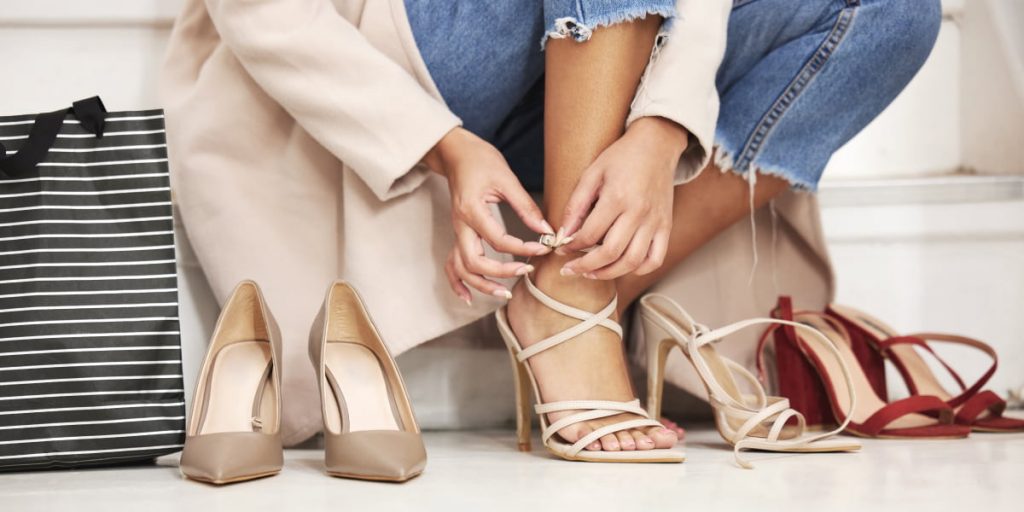Published on March 4th, 2024
Last updated on March 4th, 2024
Women’s Shoe Size Guide

Navigating the world of footwear can be a daunting task. It’s especially for women faced with the myriad of sizing options available. The women’s shoe size guide serves as an indispensable tool. It provides clarity amidst the confusion.
This guide aims to demystify the complexities of shoe sizing. It empowers women to make informed decisions when selecting the perfect pair.
From understanding the differences between various sizing systems to decoding width measurements, this women’s shoe size guide covers all aspects of finding the right fit.
Knowing one’s accurate shoe size is fundamental to both comfort and style. Women can confidently navigate the vast array of footwear options, ensuring every step they take is supported. Join us on a journey through the women’s shoe size guide. There, finding the perfect fit is no longer a challenge but a delightful discovery.
Shoe Fit Guide: Ensuring the Right Fit

Finding the perfect fit for your shoes is crucial for comfort, performance, and health. This guide offers valuable insights and tips to help you achieve the ideal fit every time. Follow these tips and guidelines. This way, you can ensure every pair of shoes you buy fits comfortably and supports your feet properly.
- Measure Both Feet: Feet can vary in size. So, according to our shoe fit guide, always measure both feet. And use the measurement of the larger foot as your guide.
- Know Your Size: Understand the sizing system used by the brand or retailer you’re purchasing from. Sizes can vary between brands and regions.
- Consider Width: Shoe width is just as important as length. If you have wider or narrower feet, look for shoes available in different width options.
- Try Before You Buy: Whenever possible, try shoes on before purchasing to assess fit and comfort. Walk around in them to ensure they feel good.
- Time of Day Matters: Feet tend to swell throughout the day. So it’s best to try shoes on in the afternoon or evening when your feet are at their largest.
- Toe Room: There should be about a thumb’s width of space between your longest toe (usually the big toe) and the end of the shoe to prevent foot injury and discomfort.
- Heel Fit: When wondering how to find the right shoe size, remember that the heel should fit snugly without slipping. If your heel slips, it can cause blisters and discomfort.
- Arch Support: Ensure the shoe provides adequate support for your arches. It’s especially true if you have high or low arches.
- Flexibility: The shoe should bend where your foot naturally bends, typically at the ball of the foot. If it doesn’t, it can lead to discomfort and foot problems.
- Consider Socks: If you typically wear socks with your shoes, try them on with the same type of socks to ensure a proper fit.
- Don’t Force It: According to our shoe fit guide, a shoe may feel uncomfortable or tight. Then, don’t force it. Even if you love the style, it’s not worth sacrificing comfort for fashion.
- Consult a Professional: If you’re unsure about your shoe size or fit, consider visiting a professional shoe fitter. They can provide personalized recommendations.
- Break Them In: Give new shoes time to break in before wearing them for extended periods. Wear them around the house for short periods to allow them to mold to your feet.
- Check for Red Flags: Pay attention to any red flags, such as pinching, rubbing, or discomfort. These could indicate that the shoes are not the right fit for you.
How to Find the Right Shoe Size

Finding the right shoe size is essential for comfort, performance, and foot health. Follow these steps to determine your correct shoe size and ensure a perfect fit every time.
- Foot Shape Matters: Consider the shape of your foot, whether it’s wide, narrow, or has unique features like bunions or hammertoes. Different shoe styles accommodate different foot shapes better.
- Materials and Construction: Pay attention to the materials and construction of the shoes. Certain materials may stretch more than others, affecting the fit over time. Also, the way a shoe is constructed can impact its flexibility and comfort.
- Brand Reputation: When wondering how to find the right shoe size, research the reputation of the brand you’re considering. Some brands are known for their consistent sizing and quality. At the same time, others may have more variability.
- Online Reviews: Before purchasing online, read reviews from other customers regarding sizing accuracy and comfort. This can provide valuable insights into whether you should size up, down, or stick true to size.
- Return Policy: Check the return policy of the retailer or brand. It’s essential to have the option to return or exchange the shoes if they don’t fit as expected.
- Consider Orthotics: According to our women’s shoe size guide, If you use orthotic inserts, make sure the shoes have enough depth and room. It’s to accommodate them comfortably without compromising fit.
- Specialty Stores: Consider shopping at specialty stores that cater to specific foot needs. Those are for wide feet, narrow feet, or orthopedic concerns.
- Future Considerations: According to our shoe fit guide, also think about any potential changes in your foot size or shape. It can be due to pregnancy, aging, or weight fluctuations. Choosing shoes with a bit of extra room can account for these changes.
- Climate and Activities: Take into account the climate and activities for which you’ll be wearing the shoes. Different environments may need different shoe styles and fit. It’s for optimal comfort and performance.
- Technology: Some brands offer innovative technologies for personalized fit and comfort. Explore options like 3D foot scanning or customizable insoles.
Women’s Average Shoe Size

Understanding the average shoe size for women can provide valuable insights. Here are some key points to consider:
- Global Variation: Women’s shoe sizes can vary significantly around the world. It’s due to factors such as genetics, ethnicity, and lifestyle. It’s essential to consider regional differences when determining average sizes.
- Measurement Methods: The average shoe size for women is typically determined by collecting data from various sources. It includes shoe retailers, manufacturers, and surveys. These measurements may vary slightly depending on the methodology used.
- Average Size Range: In many regions, the women’s average shoe size falls within the range of US size 7 to 8. However, this can vary widely based on factors such as age, height, and foot shape.
- Population Differences: Factors such as population demographics and lifestyle choices can influence average shoe sizes. For example, regions with taller populations may have larger average shoe sizes.
- Trends Over Time: Average shoe sizes for women may change over time. It’s due to changes in fashion trends, demographics, and manufacturing techniques.
- Special Considerations: Athletes or individuals with specific medical conditions may have different average shoe sizes if compared to the general population. It’s essential to consider these factors when determining average sizes.
- Industry Standards: The footwear industry often sets standard sizing guidelines. It’s to ensure consistency across brands and manufacturers. These standards may vary by region and can impact women’s average shoe size.
- Personal Variation: Average shoe sizes provide useful data points. However, it’s important to remember that individual foot sizes can vary widely. Foot width, arch height, and toe length all play a role in determining the best shoe size for an individual.
- Consultation with Experts: If unsure about the appropriate shoe size, consulting with footwear experts or using professional fitting services can help ensure a proper fit and optimal comfort.
Conclusion
Understanding the average shoe size for women is essential. It’s for selecting footwear that fits comfortably and supports overall foot health. The average size may vary globally and over time. And considering regional differences, standards, and individual variation can help guide the selection process.
By utilizing proper measurement techniques, consulting our women’s shoe size guide, and considering personal preferences and needs, women can confidently find the right shoe size for their feet.
Ultimately, prioritize foot health and fit. It ensures every step taken is supported. It allows for both women’s style and functionality in footwear choices.
FAQ
Does shoe size vary between brands?
Yes, shoe size can vary between brands. It’s due to differences in sizing systems, lasts, and manufacturing techniques. It’s essential to try on shoes from different brands to find the best fit.
What does the width letter in shoe sizing mean?
The width letter in shoe sizing refers to the width of the shoe’s footbed relative to the length. It indicates how snug or roomy the shoe will feel across the widest part of the foot. Width letters typically range from narrow (A) to extra wide (EEE).
How can I tell if a shoe fits properly?
A properly fitting shoe should feel snug but not tight, with no pressure points or pinching. There should be a thumb’s width of space between the longest toe and the end of the shoe. Walk around in the shoes to ensure they provide adequate support and comfort.
Is it normal for my shoe size to change over time?
Yes, it’s normal for shoe size to change over time due to factors such as aging, weight fluctuations, pregnancy, and changes in foot shape or arch height. Regularly measuring your feet and trying on shoes before purchasing can help ensure you find the most comfortable fit.

